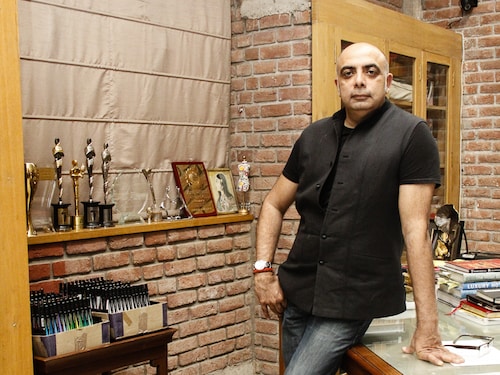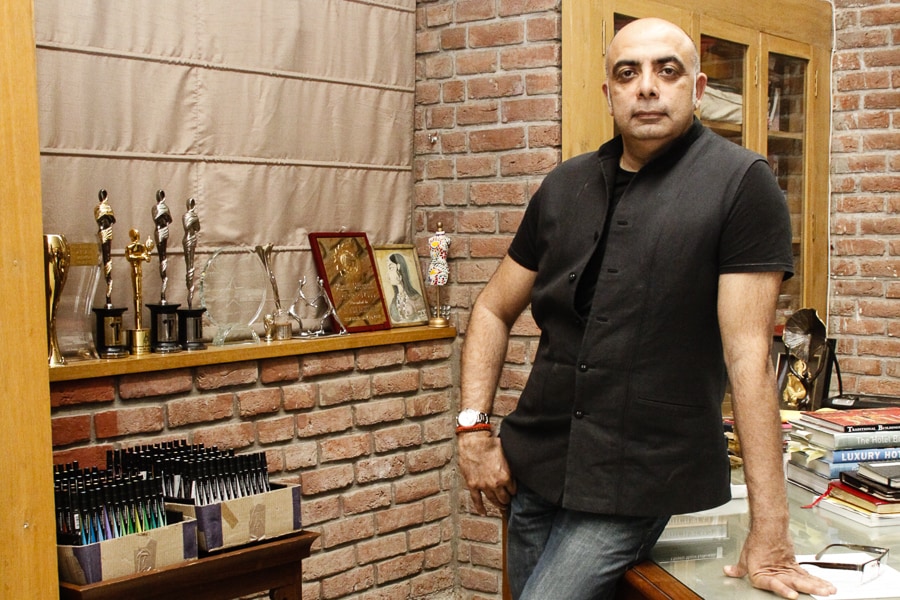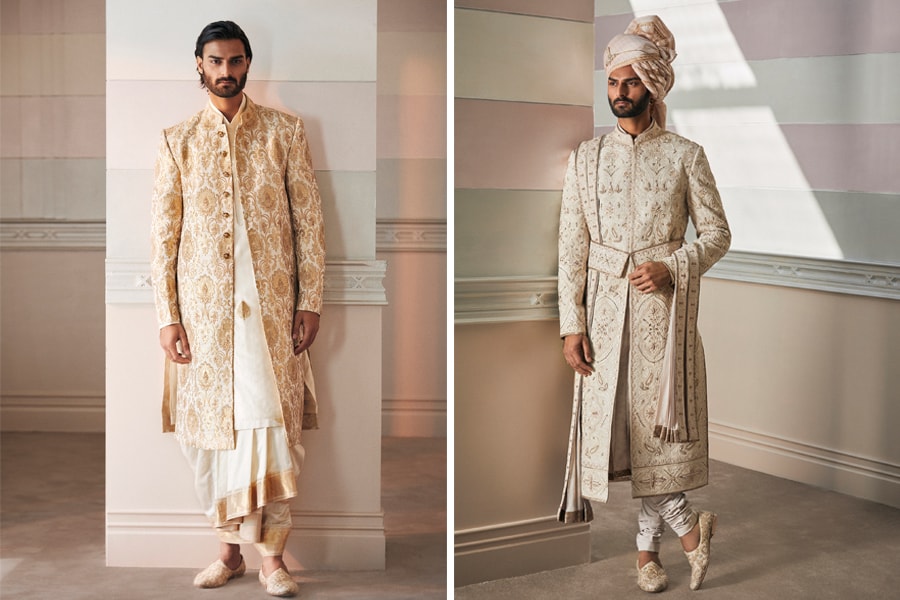Menswear section is grossly underserviced: Tarun Tahiliani
Fashion designer Tarun Tahiliani on his new menswear collection for Aditya Birla Fashion, pivoting to single-piece orders, and making e-commerce more convenient for customers



Tarun Tahiliani at his design office in Gurugram[br]
In February 2021, Aditya Birla Fashion and Retail Limited (ABFRL) bought a 33 per cent stake in fashion designer Tarun Tahiliani’s existing business for Rs67 crore. This will also result in the creation of a new subsidiary that focuses on affordable menswear, 80 per cent of which will be owned by ABFRL. The aim is to build the new brand co-created by ABFRL and Tahiliani into a Rs 500 crore business with a retail footprint of more than 250 stores across India.
Just months after the momentous news, Delhi-based Tahiliani suffered from Covid-19 and was admitted to the hospital for six days. It’s truly been a roller-coaster ride, from the very high to the very low.
And as with most of us, he has had periods of disorientation, grief and bewilderment. In an interview with Forbes India, Tahiliani talks about the industry, about what keeps him motivated in these trying times and how he continues to keep his business and team going.
Q. What are you working on currently?
I am currently working on our festive collection for 2021. We are also doing a lot of menswear because we have a wonderful new tie-up with Aditya Birla Fashion and Retail Ltd.
The plan so far is to create a range of menswear collections while having a very tight grip on the pricing. The target is to open 250 stores in five years. The scale alone would require us to do many things differently. There are some incredible and affordable fabrics that we are researching then we are associating with bigger merchants to source those fabrics.
We are reinventing internally and reworking many of our techniques to accommodate the sum of what we have signed up for and much more. We are headed towards a very exciting time and we hope that our target customers feel the same.
Q. Why menswear?
One of the many reasons that made me say yes to this partnership is that I strongly believe that Indian fashion and its consumer base, especially men, are ready for this step up. In my opinion, this section is grossly underserviced and the collaboration permits me the financial freedom to focus on designing and creating outfits for it.
I hope to give Indian men an option that they do not, I believe, have today. I think it is a new dimension for me and in India particularly, because you will get outstanding quality at great pricing from this new venture. Meanwhile, the current Tarun Tahiliani brand will continue to do high-end luxury.
Q. How are you keeping your company and business going?
I am working with pared-down numbers. We lost people who felt insecure and went back to parts of rural India or smaller towns. Nevertheless, we have been trying to run workshops from different centres outside of Delhi and ensure that our karigars have enough work.
Q. How have you reinvented your business in the current scenario and with the current buying trends?
Right now, there is no notion of ‘reinventing’ business because season-based buying ceased to be relevant. Everything is completely topsy-turvy, and people are scared to invest money at our stores because they are uncertain of what will happen next.
This has left us to rely on the hugely inefficient method of single-piece order, where customers can order any garment in any style with us from anywhere in the world and it will get produced. While the quantum of these orders is nowhere close to what we had, at least we are not incurring unnecessary costs and interest, the savings from which can be diverted to other overheads that we have to meet.
Q. What new sales, promotion and growth strategies have you adopted to push sales? Is there an online store?
The magic that one can create with fashion in person will be a challenge to put forth digitally as everyone will be trying to do the same and it will be difficult to engage viewers without causing fatigue.
Nevertheless, digital is definitely the way forward and we are collectively working on how to offer a different experience through our website, Instagram or Facebook. We are trying to think of ways of making our e-commerce experience more convenient for our customers. Our sales team is available to our customers on WhatsApp as well, showing them clothes, holding trials, etc.
Q. Many designers have gone seasonless. Have you also adopted the same strategy?
We have not gone seasonless and don’t plan to either as we believe that there is a main festive/bridal season in India, with a shorter Spring/Summer season every year, so what we produce right now will be run from July 2021 through March 2022.
That said, a lot of our evening wear is seasonless and is bought by people from around the world, so while it could be one season here in India, it is a very different season somewhere else.
Q. How is the Indian fashion industry faring currently?
The Indian fashion industry is not faring well because it primarily dresses people for special occasions, weddings and a lot of dressy socialising. The industry is not geared towards athleisure or loungewear, which is what people have used in the past year.
Q. How has the pandemic affected your life and business?
In the first wave, I was completely shocked. A lockdown was unheard of and took me by surprise. I was disoriented for almost a week before the sense of a ‘forced holiday’ sank in. But along with that also came a responsibility to do my bit for the migrant workers. So, we fed a lot of people.
Business was affected as well. A lot of people were buying smaller things and very last minute. Just a couple of days before they might need it. We had to adapt to this new demand pattern.

Tarun Tahiliani launched his S/S 2021 collection – Timelessness – on Instagram via a virtual fashion show in early March. Supporting local craftsmen and artisans, the collection introduces sherwanis with lightweight free-flowing stoles for ideal summer weddings[br]
The second wave came so suddenly. Things were just opening up and looking better and then a much worse wave hit us. It is sometimes hard to comprehend the utter chaos, loss of lives and unavailability of vaccines. But I think like a lot of people I had become numb for a while and a lot of effort just went in sourcing medicines, injections and oxygen cylinders for friends and family members. It was like being in a war.
On the business front, fashion designers’ reserves are drying up. There are hardly any sales, but one continues to work hoping that these bad times will end soon.
Q. What is the hope you see for the industry?
I feel this pause that the pandemic has imposed upon us has forced us go inwards and think about our identity, about who we truly are. We have become extremely conscious of our ‘Indian-ness’. I think that life has changed and therefore fashion must change too to reflect this new vision and identity.
Q. Thanks to American and Chinese buyers, the international luxury industry is reviving rapidly. Do you think Indians too will indulge in revenge buying after the pandemic?
The Chinese continued to have a strong economy despite the pandemic because they were able to control it fast. The Americans, even though they had a lockdown, were funded by the state and billions of dollars in the form of relief packages were deposited into their accounts, which drives demand.
Unfortunately, in India, this has not been the case and despite the scale of the pandemic and the second lockdown, there have not really been any adequate public assistance programmes. Additionally, many Indians with deep pockets have actually left the country in these difficult times, which will also affect the overall economic climate here. Therefore, the Indian economy is going to contract, and we are not going to recover in the same way as China or the US.
Q. What motivates you to keep going in these uncertain times?
The fact that I must run a business and support my team keeps me going. I must take care of units in Faridabad and Kolkata. Despite minimum sales, we have not stopped work. We are working on a new menswear collection. We are also working on creating better content for Instagram. When you are creating something, you forget everything else that is happening in the world.
The trick really is to keep going.
On the personal front, I have forced myself into a routine, which is helping me. In the first lockdown I learnt that it is very easy to get sucked into sensational news and unending screen time. So, this time around I am being more disciplined. Overall, I have been living a healthier life and I like that.
Another very important thing to hold on to is a sense of gratitude. When I was hospitalised, I knew that I was lucky to have been getting great care. I would tell my nurses, doctors, and medical staff every day that they were doing a great, great job.
Q. How do you keep your team motivated?
By looking ahead and focusing on the future. It is important to keep people busy and make them feel part of something new, big, and exciting. Also, it is important to create a safe, positive, and cheerful environment to work in. One must also instill a sense of gratitude among team members, be thankful for having work, for being able to create something new even in these challenging times.
Q. How have you evolved as a leader in these trying times?
I have become calmer, more empathetic to everyone’s problems, more mindful and less distracted.
Q. By when do you think the Indian fashion industry will recover from the economic slowdown caused by the pandemic?
I guess it will recover when the economy recovers, when restrictions are lifted, people are safe and can go back to a life that requires dressing up.
First Published: Jun 05, 2021, 11:06
Subscribe Now